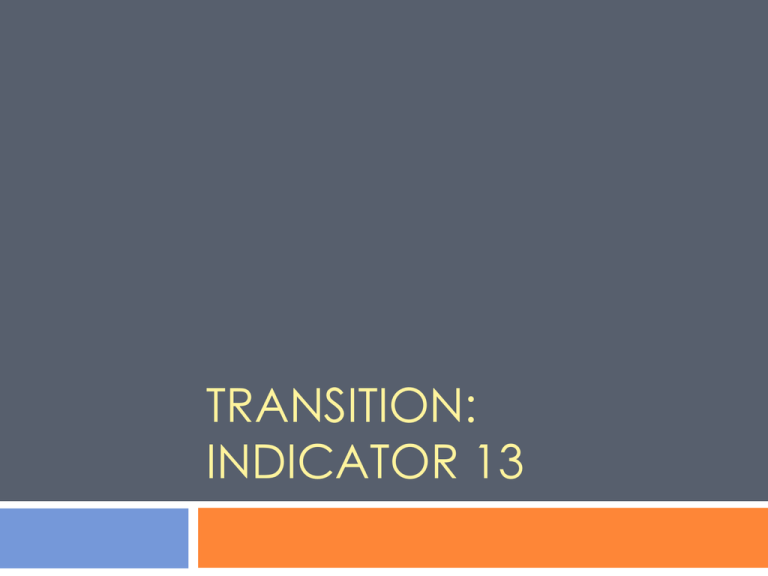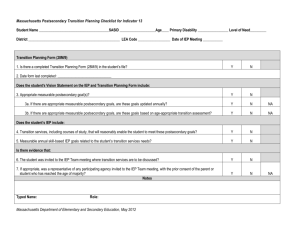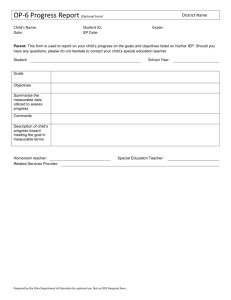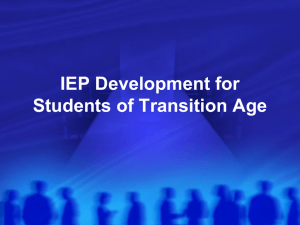Transition: Indicator 13
advertisement

TRANSITION: INDICATOR 13 Transition Planning The transition planning process is to address the transition service needs of students with disabilities through coordinated planning among special educators, general educators, community service agencies, parents and students. This process requires collaboration across service delivery systems to improve the quality and extent of available transition services. Transition Participation When it is likely that a student will be involved with other agencies that provide or pay for transition services or postsecondary services, it is appropriate for representatives from such agencies to be invited to the student’s IEP team meeting. The involvement and collaboration with other public agencies (e.g., vocational rehabilitation agencies, the Social Security Administration, etc.) can be helpful in planning for transition and in providing resources that will help students when they leave high school. Notification to Voc Rehab When a student turns age 16, the IEP team must consider if the student’s post-school employment goal(s) warrant a notification to Vocational Rehabilitation. This is a notification only, not a referral for services. If notification is determined to not be appropriate, the IEP must show documentation of the team’s decision. If notification is sent, it is important to remember that personally identifiable information is being shared and parent consent for release of information is required. Transition Assessment The purpose of transition assessment is to provide information to develop and write practical, achievable measurable postsecondary goals and assist in the identification of transition services necessary in helping the student reach those goals. Transition assessment must be conducted prior to the student reaching age 14 and prior to the development of the measurable postsecondary goals and transition services in the students IEP. For each of the postsecondary goal areas addressed in the student’s IEP there are to be age-appropriate transition assessment information provided on the student’s needs, taking into account the student’s strengths, preferences, and interests regarding each postsecondary goal. The assessment information can be documented either in the IEP or in the student’s file. Transition Assessment Questions 1. 2. 3. What does the student want to do beyond school (e.g., further education or training, employment, military, continuing or adult education, etc.)? Where and how does the student want to live (e.g., dorm, apartment, family home, group home, supported or independent)? How does the student want to take part in the community (e.g., transportation, recreation, community activities, etc.)? Other Assessments Students may already have some data sources on file, such as: • State mandated test scores (standardized or alternate) • Current psychological evaluation data • Quarterly grades, semester grades, and/or progress notes • Career Interest Inventory, Adaptive Behavior Scale, and/or Career Skill Inventory. Measurable Post Secondary Goals or MPG These may not be the desired goals or visions that the educational professionals or parents hold for the student, but rather are those goals, dreams, interests and aspirations held by the student for how he or she wants to live after high school. It is possible that based on all these factors the student’s postsecondary goals may change from year to year. MPG addresses: Training/Education – specific vocational or career field, vocational training program, apprenticeship, on the job training, military, Job Corps, etc. or 4 year college or university, technical college, 2 year college, military, etc. Employment - paid (competitive, supported, sheltered), unpaid, nonemployment, etc. Independent living skills – daily living skills, adult living, independent living, financial, transportation, leisure/recreation, home maintenance and personal care, and community participation, etc. MPG Postsecondary goals should be written in results-oriented terms such as “enroll in”, “work”, “live independently” and use descriptors such as “full time” and “parttime” for clarification. Terms like “wishes”, “wants”, “plans”, and “desires” do not meet the requirement for measurable. Measurable MPG “I will attend WSU in the teacher education program.” It is possible to measure whether the student does or does not “attend”, therefore, this is an acceptable measurable postsecondary goal that addresses the required area of education/training. Not measurable MPG “I am planning on attending WSU in the teacher education program.” It is not possible to measure whether the student is “planning on attending”, therefore, this is not an acceptable measurable postsecondary goal that addresses the required area of education/training. More MPGs Handout Indicator 13 Checklist: Form B Courses of Study The IEP that will be in effect when the student turns age 14 must address the courses of study needed to assist the student in reaching his or her postsecondary goals. Courses of study are defined as a multiyear description of coursework to achieve the student’s desired post-school goals, from the student’s current to anticipated exit year. Courses of Study The courses of study should be identified on the student’s IEP as a list of courses of study rather than a statement of instructional program. The IEP team should work closely with the guidance counselor who keeps a transcript of required courses toward graduation. Courses of Study Each year the IEP team, including the student, reconsiders the student’s postsecondary goals and aligns the courses of study with those desired goals. The decisions regarding the courses of study should relate directly to where the student is currently performing and what he or she wants to do after graduation. Course of Study Questions Do the transition services include courses of study that focus on improving the academic and functional achievement of the child to facilitate their movement from school to post-school objectives? Do the transition services include courses of study that align with the student’s postsecondary goal(s)? Kansas Career Clusters as Courses of Study( Courses of Study) Many Kansas schools implement the Career Clusters or Kansas Career Pathways. These programs foster lifelong career development, a meaningful work life, and a future for employment or education/training for students. Transition Services The age 16 transition services will build from the PLAAFP which describe where the student is currently performing in relationship to his postsecondary goals. With that as the starting point, the team needs to determine what skills, services, or supports the student will need in order to successfully transition from where he or she is now to his or her desired postsecondary goals. Services The IEP team is to consider and include in the IEP any potential services needed in the areas of instruction, related services, community experiences, employment, and when appropriate, daily living skills and the provision of a functional vocational evaluation, to support the student in reaching his or her postsecondary goals. Questions What services, supports or programs does this student currently need? (For example, specially designed instruction, accommodations and modifications, related services, job coaching, special transportation etc.) What services, supports or programs will this student need in order to achieve his or her desired postsecondary goals and lead to success as the student leaves high school? Are linkages being made to the needed post-school services, supports or programs before the student leaves the school setting? Do the age 16 transition services include strategies to ensure students and parents are aware of, and connected to, needed post-school services, programs and supports before the student exits the school system? Instruction the student needs to receive in specific areas to complete needed courses, succeed in the general curriculum and gain needed skills post high school. Related services the student may need to benefit from special education while in school. Generally, the IEP team should also begin to consider related service needs the student may have as he or she enters the adult world. If related services will be needed beyond school, the IEP should identify, as appropriate, linkages to adult agencies or providers before the student leaves the school system. Community experiencesthat are provided outside the school building or in community settings. Examples may include community-based work experiences and/or exploration, job site training, banking, shopping, transportation, counseling and recreation activities. Employment or other post-school adult living objectives the student needs to achieve desired post-school goals. These could be services leading to a job or career or those that support activities done occasionally such as registering to vote, filing taxes, renting a home, accessing medical services, filing for insurance or accessing adult services such as Social Security Income (SSI). Acquisition of daily living skills. Daily living skills are those activities that adults do every day (e.g., preparing meals, budgeting, maintaining a home, paying bills, caring for clothes, grooming, etc.). Functional vocational evaluation. This is an assessment process that provides information about job or career interests, aptitudes and skills. Information may be gathered through situational assessment, observation, or formal measures and should be practical. The IEP team could use this information to refine services outlined in the IEP. Transition Services Worksheet H:\Transition-Cutting EdJ\blank_CS.doc Criteria for Meeting I-13 For transition services that are likely to be provided or paid for by other agencies, with parent (or child once age of majority is reached)consent, is there evidence that the representatives of the agency(ies) were invited to the IEP meeting? (#5) Criteria for I-13 Is there evidence that the measurable postsecondary goals were based on an age-appropriate transition assessment? (#15) Criteria for I-13 Do the transition services include courses of study that focus on improving the academic and functional achievement of the child to facilitate their movement from school to post-school? (#20) Indicator 13 Checklist Handout Groups http://www.nsttac.org/tm_materials/Defa ult.aspx Choose a student to study Look at the examples under #1-6 Reviewing your IEP, answer the questions under the Checklist. LCNCK results for I-13 Action Plan Groups work on Action Plan for LCNCK Websites http://www.nsttac.org/tm_materials/Defa ult.aspx National Secondary Transition Technical Assistance Center http://www.ksde.org/Default.aspx?tabid= 2587 Kansas Transition Webkidss http://www.gckschools.com/users/cristn







